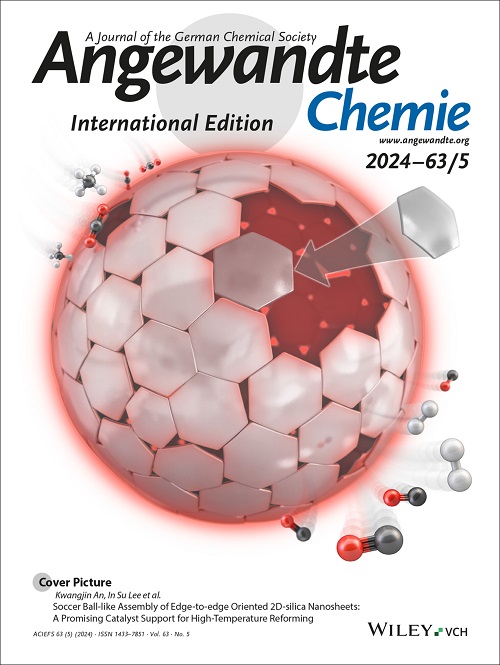破译色氨酸氧合:MarE中2 -氧吲哚形成的关键调节剂
IF 16.1
1区 化学
Q1 CHEMISTRY, MULTIDISCIPLINARY
引用次数: 0
摘要
MarE是一种血红素依赖的芳香加氧酶,具有组氨酸轴向连接,催化β -甲基- L -色氨酸的单氧合,形成马霉素生物合成中心的2 -氧吲哚支架。虽然结构类似于色氨酸2,3 -双加氧酶(TDO),通过双加氧启动L -色氨酸分解代谢,但MarE表现出受抗坏血酸调节的独特反应性。虽然抗坏血酸对TDO没有影响,但它促进了MarE的选择性单氧合。在缺乏它的情况下,MarE有利于双氧化和形成类似呋喃吲哚的产物,揭示了潜在的催化多功能性。两种酶(MarE中的SLGGR和TDO中的GTGGS)的活性位点环序列不同,促使环交换实验探索结构-功能关系。用MarE - like序列(GTGGA或SLGGS)取代TDO中的GTGGS将反应性转向单氧化,并形成C3 -羟基化的非氧化多酚产物,这些产物进一步环化成三环结构。相反,在增强的C2、C3 -双氧作用中,用GTGGS代替MarE中的SLGGR几乎翻了4倍。这些结果强调了除抗坏血酸外,活性位点环也是氧化结果的关键决定因素。证明了活性位点环在氧化位点偏好中的关键作用。通过揭示MarE的真正催化特性,描述小分子效应物和环结构的作用,本研究推进了对加氧酶超家族的机制理解和预测能力。本文章由计算机程序翻译,如有差异,请以英文原文为准。
Deciphering Tryptophan Oxygenation: Key Modulators of 2‐Oxindole Formation in MarE
MarE, a heme‐dependent aromatic oxygenase with a histidyl axial ligated, catalyzes the monooxygention of β‐methyl‐L‐tryptophan, to form a 2‐oxindole scaffold central to maremycin biosynthesis. Although structurally similar to tryptophan 2,3‐dioxygenase (TDO), which initiates L‐tryptophan catabolism via dioxygenation, MarE exhibits distinct reactivity modulated by ascorbate. While ascorbate has no effect on TDO, it promotes selective monooxygenation by MarE. In its absence, MarE favors dioxygenation and formation of furoindoline‐like products, revealing a latent catalytic versatility. Active‐site loop sequences differ between the two enzymes, SLGGR in MarE versus GTGGS in TDO, prompting loop‐swapping experiments to probe structure‐function relationships. Substituting GTGGS in TDO with MarE‐like sequences (GTGGA or SLGGS) shifted reactivity toward monooxygenation and formation of C3‐hydroxylated, non‐oxindole products that underwent further cyclization into three‐ring structures. Conversely, replacing SLGGR in MarE with GTGGS in enhanced C2,C3‐dioxygenation nearly 4‐fold. These results underscore the active‐site loop as a key determinant of oxidation outcome in addition to ascorbate. demonstrating the critical role of the active site loop in oxidation site preference. By revealing the true catalytic identity of MarE and delineating the roles of small‐molecule effectors and loop architecture, this study advances mechanistic understanding and predictive capabilities within the oxygenase superfamily.
求助全文
通过发布文献求助,成功后即可免费获取论文全文。
去求助
来源期刊
CiteScore
26.60
自引率
6.60%
发文量
3549
审稿时长
1.5 months
期刊介绍:
Angewandte Chemie, a journal of the German Chemical Society (GDCh), maintains a leading position among scholarly journals in general chemistry with an impressive Impact Factor of 16.6 (2022 Journal Citation Reports, Clarivate, 2023). Published weekly in a reader-friendly format, it features new articles almost every day. Established in 1887, Angewandte Chemie is a prominent chemistry journal, offering a dynamic blend of Review-type articles, Highlights, Communications, and Research Articles on a weekly basis, making it unique in the field.

 求助内容:
求助内容: 应助结果提醒方式:
应助结果提醒方式:


